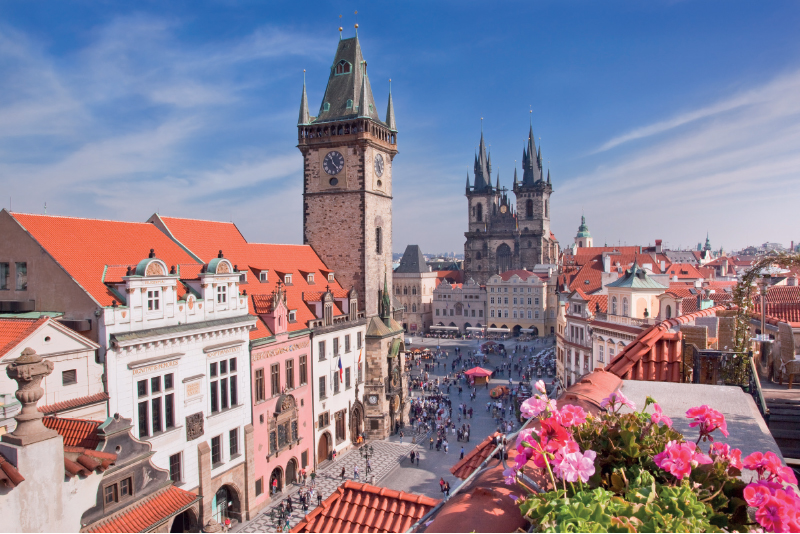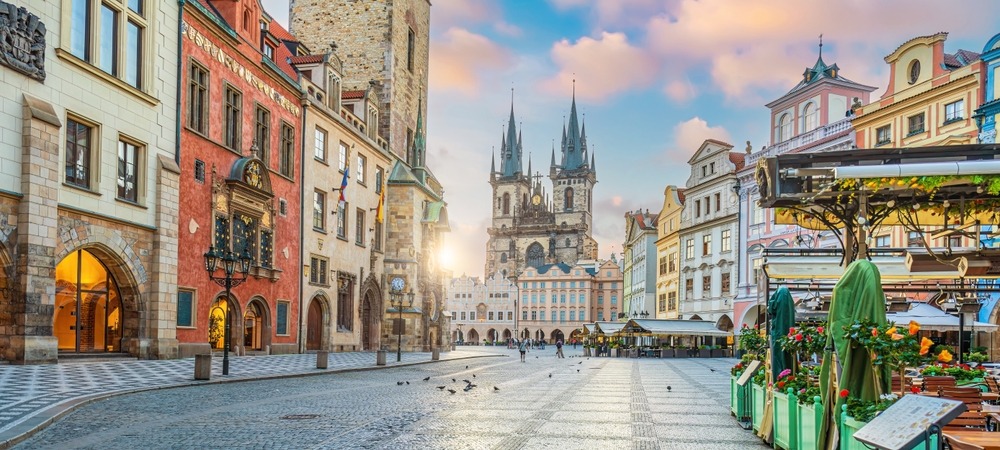Prague: A Tapestry of Time and Beauty in the Heart of Europe
The History of Prague – City of a Hundred Spires
Prague, the capital of the Czech Republic, is one of Europe’s most historically layered and architecturally stunning cities. Nestled along the banks of the Vltava River, Prague has been a cultural, political, and economic center of Central Europe for over a thousand years. Its story begins in the Paleolithic era, but Prague’s formal founding is traced to the 9th century with the establishment of Prague Castle by the Přemyslid dynasty, marking the beginning of a continuous royal presence that would shape the city for centuries.
By the 10th century, Prague had become the seat of the dukes of Bohemia and an important trade center linking Eastern and Western Europe. In 1085, Vratislaus II became the first king of Bohemia, cementing Prague’s status as a royal capital. The city flourished under the Holy Roman Emperor Charles IV in the 14th century, who made Prague the imperial capital and founded Charles University in 1348, the oldest university in Central Europe. During this era, Charles IV also initiated extensive construction projects, including the famous Charles Bridge and the Gothic expansion of Prague Castle.

The 15th century brought religious and political upheaval with the rise of Jan Hus and the Hussite Wars, a precursor to the Protestant Reformation. Prague remained a hotbed of intellectual and religious debate, and its divided loyalties were evident during the Defenestration of Prague in 1618, an event that ignited the Thirty Years’ War.
In the 18th and 19th centuries, Prague became a key part of the Habsburg Empire and experienced rapid industrialization. It was during this time that Czech nationalism gained momentum, ultimately leading to the creation of Czechoslovakia in 1918 after World War I, with Prague as its capital. The city endured the trials of Nazi occupation during World War II and the imposition of communist rule after 1948, culminating in the Prague Spring of 1968—a brief period of political liberalization crushed by Soviet forces.
With the Velvet Revolution of 1989, communism collapsed peacefully, and Prague emerged as the democratic capital of the newly formed Czech Republic in 1993. Since then, it has become a vibrant symbol of European rebirth, known for its remarkably preserved medieval core, baroque grandeur, and cultural sophistication.

Top 25 Attractions in Prague
1. Prague Castle
Overlooking the city from a hilltop, Prague Castle is the largest ancient castle complex in the world. It includes St. Vitus Cathedral, the Old Royal Palace, and the picturesque Golden Lane. A walk through its grounds reveals centuries of Czech history and imperial grandeur.
2. Charles Bridge (Karlův most)
Constructed in the 14th century under Charles IV, this iconic stone bridge connects the Old Town with the Lesser Town (Malá Strana). Lined with 30 statues of saints, it offers a romantic view of the Vltava River and Prague’s skyline.
3. Old Town Square (Staroměstské náměstí)
The heart of Prague’s medieval district, this square features colorful baroque buildings, the Church of Our Lady before Týn, and the famous Prague Astronomical Clock (Orloj), which puts on a mechanical show every hour.
4. St. Vitus Cathedral
Within Prague Castle, this soaring Gothic cathedral is the spiritual heart of the Czech Republic. It houses the tombs of Bohemian kings and the Crown Jewels and offers panoramic views from its bell tower.
5. Astronomical Clock (Orloj)
Installed in 1410, this medieval clock is one of the oldest functioning astronomical clocks in the world. Its hourly procession of the Twelve Apostles draws crowds daily.
6. Wenceslas Square
This vibrant boulevard in New Town is both a commercial hub and a historic site of political change, including the Velvet Revolution. At the top stands the statue of St. Wenceslas and the National Museum.
7. The Jewish Quarter (Josefov)
This historic district offers poignant insights into Prague’s Jewish heritage. Highlights include the Old-New Synagogue, the Jewish Museum, and the hauntingly beautiful Old Jewish Cemetery.
8. The Lennon Wall
A symbol of peace, freedom, and resistance, this ever-changing wall of graffiti features images and messages inspired by John Lennon and the spirit of protest during the communist era.
9. Petrin Hill and Observation Tower
Modeled after the Eiffel Tower, the Petrin Observation Tower offers panoramic views of Prague. The surrounding park is ideal for a tranquil escape from the bustling city.
10. Dancing House (Tančící dům)
A striking piece of modern architecture, this curvaceous building designed by Frank Gehry and Vlado Milunić stands out amid Prague’s baroque and gothic silhouettes.
11. Vyšehrad
This historic fort atop a bluff south of the city center is older than Prague Castle. It offers scenic views and houses the Basilica of St. Peter and St. Paul and a cemetery where many Czech luminaries are buried.
12. Strahov Monastery and Library
Founded in 1143, this monastery boasts one of the most beautiful libraries in the world. Its two magnificent halls feature ceiling frescoes and ancient theological and philosophical texts.
13. National Theatre (Národní divadlo)
A symbol of Czech national identity, this neo-Renaissance theater stages opera, drama, and ballet in an opulent setting along the Vltava River.
14. Powder Tower (Prašná brána)
This 15th-century Gothic tower was one of the original city gates. It marks the beginning of the Royal Route leading to the castle.
15. Letná Park
Once the site of a giant Stalin monument, Letná now offers some of the city’s best panoramic views and is a favorite spot for locals to relax.
16. Kampa Island
This charming islet on the Vltava is known for its art installations, peaceful canals, and the modernist Museum Kampa.
17. Church of St. Nicholas (Malá Strana)
A baroque masterpiece with a stunning dome and ornate interior, this church is a visual highlight of the Lesser Town district.
18. National Museum (Národní muzeum)
Dominating the top of Wenceslas Square, this massive institution houses extensive collections in natural history, anthropology, music, and more.
19. Museum of Communism
A sobering look at Czech life under communist rule, this museum features propaganda, surveillance equipment, and immersive exhibits.
20. Franz Kafka Museum
Dedicated to one of Prague’s most famous literary figures, this museum explores Kafka’s surreal world and his connection to the city that shaped his work.
21. Municipal House (Obecní dům)
This art nouveau gem is a cultural venue and architectural marvel. Inside, visitors can see the exquisite Smetana Hall and murals by Alfons Mucha.
22. Vrtba Garden (Vrtbovská zahrada)
A hidden baroque gem on the slopes of Petřín Hill, this terraced garden offers tranquility and beautifully manicured landscapes in the heart of the city.
23. Troja Palace (Trojský zámek)
A baroque chateau with ornate frescoes and sprawling gardens, Troja Palace also hosts art exhibitions and is near the Prague Zoo.
24. Prague Zoo
Ranked among the best in the world, the Prague Zoo houses over 4,000 animals and is located near the scenic Troja district.
25. DOX Centre for Contemporary Art
A bold addition to Prague’s cultural scene, this modern space showcases thought-provoking exhibitions in visual arts, architecture, and design.

Prague’s magic lies in its seamless blend of ancient grandeur and modern vitality. From Gothic cathedrals to baroque palaces, from quiet cobbled lanes to bustling squares, every corner of the city whispers tales of emperors, artists, reformers, and revolutionaries. As a capital that has stood at the crossroads of European history, Prague remains not only a treasure trove for historians and architecture lovers but also a dynamic destination for today’s global traveler.

































